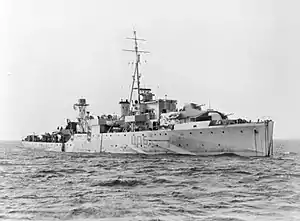HMS Chanticleer (U05)
HMS Chanticleer was a modified Black Swan-class sloop of the Royal Navy. She was laid down by William Denny and Brothers, Dumbarton on 6 June 1941, launched on 24 September 1942 and commissioned on 29 March 1943, with the pennant number U05.[1]
 HMS Chanticleer at the Clyde in 1943. | |
| History | |
|---|---|
| Name | Chanticleer |
| Namesake | Chanticleer |
| Ordered | 9 January 1941 |
| Builder | William Denny and Brothers, Dumbarton |
| Laid down | 6 June 1941 |
| Launched | 24 September 1942 |
| Commissioned | 29 March 1943 |
| Renamed |
|
| Identification | Pennant number: U05 |
| Fate | Scrapped in 1946 |
| General characteristics | |
| Class and type | Modified Black Swan-class sloop |
| Displacement | 1,350 tons |
| Length | 283 ft (86 m) |
| Beam | 38.5 ft (11.7 m) |
| Propulsion |
|
| Speed | 20 knots (37 km/h) at 4,300 hp (3,200 kW) |
| Complement | 192 men + 1 Cat |
| Armament |
|
Construction and career
After trials and operational commissioning at Tobermory, in May 1943, the Chanticleer was assigned to the 7th Escort Group based at Greenock for convoy escort missions in the Atlantic.
In June 1943, she took part in various missions to protect convoys such as a floating dock towed from Oban to Malta by the passage through Gibraltar or the KMF18 convoy escort between Gibraltar and the United Kingdom.
In July 1943, the Chanticleer accompanied the KMF19 convoy during the passage through Beach Head, in Sicily, then joined the Eastern Support Force to support the Allied landings, Operation Husky. Upon liberation from Operation Husky, the Chanticleer resumed the escort of the Atlantic convoys and her support functions.
On 15 November 1943, at 3:24 p.m., during the defence of the combined convoy MKS30 and SL139 against the attacks from U-Boats of the Wolfpack Schill 1 (activated from 16 to 22 November 1943 and composed of the following eight U-Boats: U-211, U-228, U-262, U-333, U-358, U-426, U-516 and U-600), HMS Chanticleer was hit by an acoustic torpedo (T5-GNAT) fired from U-515, 400 kilometres east-northeast of the island of San Miguel, Azores. 29 men died.[2] The severely-damaged sloop was towed by HMS Salveda to Horta in the Azores, where it was declared a total loss.[3]
The ship was then transformed into a pontoon and used as a base ship for Royal Navy personnel serving in Horta and was renamed Hesperides. On 31 December 1943 her name was changed to Lusitania II, but the ship continued to be used as a base ship for the remainder of the European War when it was deactivated again. She was sold for dismantling in Lisbon in 1946.[4]
References
- "HMS Chanticleer (U 05) (British Sloop) - Ships hit by German U-boats during WWII - uboat.net". uboat.net. Retrieved 20 October 2020.
- "HMS Chanticleer (U 05) (British Sloop) - Ships hit by German U-boats during WWII - uboat.net". uboat.net. Retrieved 13 April 2021.
- "HMS Chanticleer (U 05) (British Sloop) - Ships hit by German U-boats during WWII - uboat.net". uboat.net. Retrieved 20 October 2020.
- "HMS Chanticleer, sloop". www.naval-history.net. Retrieved 20 October 2020.
Further reading
- HMS Chanticleer’s crewlist
- Blackman, Raymond V. B. (1971). Jane's Fighting Ships 1971–72. London: Sampson Low, Marston & Company. ISBN 0-354-00096-9.
- Blair, Clay Gardiner (2000). Hitler's U-Boat War: The Hunted 1942–1945. New York: Modern Library. ISBN 0-679-64033-9.
- Gardiner, Robert Gardiner (1980). Conway's All the World's Fighting Ships 1922-1946. Conway Maritime Press. p. 456. ISBN 0-85177-146-7.
- Gardiner, Robert Gardiner (1996). Conway's All the World's Fighting Ships 1947-1995. US Naval Institute Press. p. 675. ISBN 1-55750-132-7.
- Colledge, J. J.; Warlow, Ben (2006) [1969]. Ships of the Royal Navy: The Complete Record of all Fighting Ships of the Royal Navy (Rev. ed.). London: Chatham Publishing. ISBN 978-1-86176-281-8.
- Hague, Arnold (1993). Sloops: A History of the 71 Sloops Built in Britain and Australia for the British, Australian and Indian Navies 1926–1946. Kendal, England: World Ship Society. ISBN 0-905617-67-3.